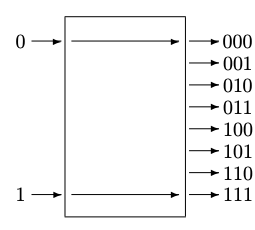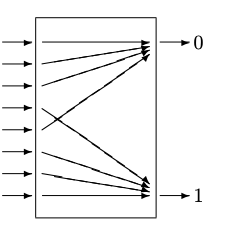7.4.1: Error Correcting Example
- Page ID
- 51267
The Hamming Code encoder and decoder can be represented as discrete processes in this form. Consider the (3, 1, 3) code, otherwise known as triple redundancy. The encoder has one 1-bit input (2 values) and a 3-bit output (8 values). The input 1 is wired directly to the output 111 and the input 0 to the output 000. The other six outputs are not connected, and therefore occur with probability 0. See Figure 7.8(a). The encoder has \(N\) = 0, \(L\) = 0, and \(M = I = J\). Note that the output information is not three bits even though three physical bits are used to represent it, because of the intentional redundancy.
The output of the triple redundancy encoder is intended to be passed through a channel with the possibility of a single bit error in each block of 3 bits. This noisy channel can be modelled as a nondeterministic process with 8 inputs and 8 outputs, Figure 7.8(b). Each of the 8 inputs is connected with a (presumably) high-probability connection to the corresponding output, and with low probability connections to the three other values separated by Hamming distance 1. For example, the input 000 is connected only to the outputs 000 (with high probability) and 001, 010, and 100 each with low probability. This channel introduces noise since there are multiple paths coming from each input. In general, when driven with arbitrary bit patterns, there is also loss. However, when driven from the encoder of Figure 7.8(a), the loss is 0 bits because only two of the eight bit patterns have nonzero probability. The input information to the noisy channel is 1 bit and the output information is greater than 1 bit because of the added noise. This example demonstrates that the value of both noise and loss depend on both the physics of the channel and the probabilities of the input signal.
The decoder, used to recover the signal originally put into the encoder, is shown in Figure 7.8(c). The transition parameters are straightforward—each input is connected to only one output. The decoder has loss (since multiple paths converge on each of the outputs) but no noise (since each input goes to only one output).
 (a) Encoder
(a) Encoder (b) Channel
(b) Channel (c) Decoder
(c) DecoderFigure 7.8: Triple redundancy error correction


